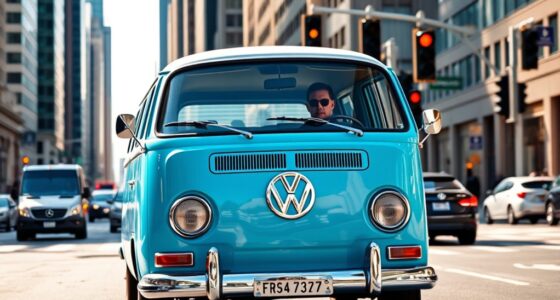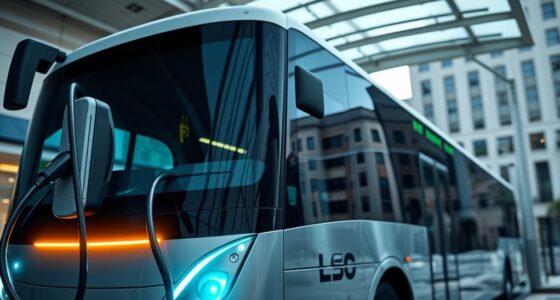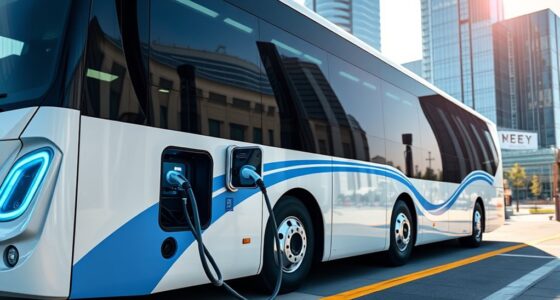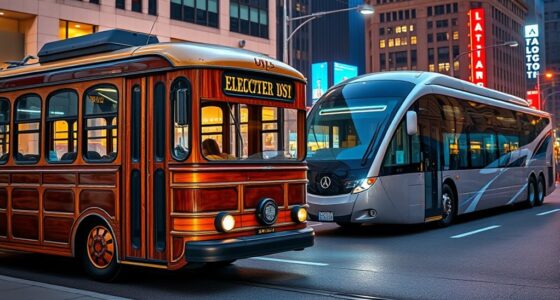Understanding VW bus terminology helps you identify and restore different models more accurately. Terms like “Splitty” refer to buses from 1950-1967 with split windshields, while “Westy” indicates camper conversions with fold-out beds and vintage accessories. “Bay Window” denotes second-generation models from 1968-1979, featuring larger windows. Knowing these names guarantees you find the right parts and accessories, preserving each vehicle’s unique style. Keep exploring to uncover more about these iconic models and their authentic features.
Key Takeaways
- “Splitty” refers to VW buses from 1950-1967 with distinct split windshields.
- “Westy” indicates Westfalia camper conversions from the 1960s-70s, featuring fold-out beds and kitchen units.
- “Bay Window” describes the second-generation VW bus (1968-1979) with larger windows and modern styling.
- Understanding these terms helps identify models and source era-specific vintage accessories for authentic restoration.
- Correct terminology improves communication, sourcing, and ensures restorations maintain the vehicle’s original character.

Ever wondered what all the terms related to VW buses really mean? If you’re diving into the world of vintage Volkswagens, understanding the lingo can make a big difference in your restoration projects and when shopping for vintage accessories. Knowing these terms helps you communicate better with sellers, mechanics, and fellow enthusiasts, ensuring you get exactly what you need to bring your bus back to life or personalize it with a unique touch.
Take “Splitty” as an example. This nickname refers to the early first-generation VW buses built between 1950 and 1967, characterized by their split windshield design. Being familiar with this term helps you identify the original models, which are often highly sought after for restoration. When you’re looking for vintage accessories, knowing whether a bus is a “Splitty” or a later model helps you choose the right parts, from classic roof racks to period-correct interior fittings. Restoration tips for Splittys include paying close attention to the chassis and sheet metal, as these models are more prone to rust due to their age, and sourcing authentic vintage accessories can truly enhance their original look.
“Splitty” refers to early VW buses (1950-1967) with split windshields, key for restoration and authentic vintage parts.
Moving on, “Westy” is a popular nickname for the Westfalia camper conversions that became iconic in the ’60s and ’70s. These conversions transformed standard buses into compact, functional campers with fold-out beds, kitchenette units, and storage solutions. If you’re restoring a Westy, understanding its unique features can help you maintain its authenticity. When hunting for vintage accessories, look for period-correct pop-top tents, original interior panels, and vintage camping gear—these details add character and value to your restoration project.
Another common term is “Bay Window,” which refers to the second-generation VW buses produced from 1968 to 1979. These models feature larger windows and a more modern look, making them desirable for customization or restoration. Restoring a Bay Window involves different challenges, like upgrading the electrical system or replacing the interior upholstery. Vintage accessories for this model include retro steering wheels, classic hubcaps, and authentic decals, all of which help preserve its vintage appeal.
In the world of VW buses, knowing what terms like “Splitty,” “Westy,” or “Bay Window” mean isn’t just about jargon—it’s about connecting with the history and culture of these vehicles. It guides your restoration tips, helps you find the right vintage accessories, and ensures your project stays true to its roots. Whether you’re aiming to restore a classic or personalize your bus with vintage accessories, understanding these terms makes your journey smoother, more enjoyable, and ultimately more rewarding. Additionally, understanding the different models aids in sourcing vintage accessories that match the specific era and style of your bus.
Frequently Asked Questions
What Are the Main Differences Between Type 2 and Type 1 VW Buses?
When comparing Type 2 and Type 1 VW buses, you’ll notice Type 2, or “Bay Window,” offers more interior space and a boxier design, making it ideal for van conversions and vintage restoration. Type 1, or “Splitty,” has a rounded shape and simpler mechanics, perfect for classic restorations. Your choice depends on your project goals; both are fantastic for customizing and creating a unique vintage van experience.
How Did the “Bay Window” VW Bus Get Its Name?
You might wonder how the “bay window” VW bus got its name. It’s because of the iconic, large front windshield resembling a bay window in a house. This model features air-cooled engines and is popular for classic restoration techniques. The name highlights its distinctive, expansive glass area, which became a signature look. If you’re restoring one, knowing this history enhances your appreciation for its unique design and charm.
Are There Common Issues Specific to Certain VW Bus Models?
You’ll notice that certain VW Bus models face common issues like rust corrosion, especially around the wheel wells and undercarriage, due to age and exposure. Electrical issues also pop up, often affecting lighting or wiring harnesses, making troubleshooting tricky. If you’re restoring or maintaining a specific model, knowing these common problems helps you catch early signs and keep your bus running smoothly.
What Are the Original Factory Color Options for Vintage VW Buses?
Imagine opening a time capsule—your vintage VW bus’s original factory colors reveal its true story. You’ll find classic restoration paint schemes, often inspired by vibrant hues of the 1950s and ‘60s. Factory color codes guide your restoration, ensuring authenticity. Popular options include pastel shades like light blue, mint green, and beige, each capturing the cheerful spirit of the era. Your bus’s original color adds character and history to every journey.
How Can I Identify a Genuine Westfalia Camper Conversion?
To identify a genuine Westfalia camper conversion, start by checking authenticity markers like the original Westfalia badge, factory-installed features, and specific interior layouts. Restoration tips include examining the cabinetry, upholstery, and appliances for original parts or period-correct updates. Look for consistent paint and finish, and verify VIN numbers and serial codes. These details help confirm its authenticity and ascertain you’re looking at a true Westfalia camper, not a retrofit or replica.
Conclusion
Now you’re well-equipped to navigate VW Bus lingo, from ‘Westy’ to ‘Splitty’. Remember, understanding these terms is like knowing the language of a trusted friend—once you get it, everything becomes clearer. As the saying goes, “A journey of a thousand miles begins with a single step.” Keep learning, stay curious, and soon you’ll be speaking VW Bus fluently, making every adventure even more memorable.









